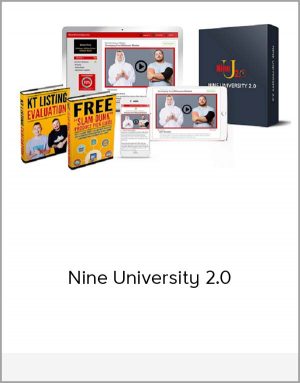Robin Knowles – The Beginner’s Guide to OpenFOAM on AWS
$30.00$79.00 (-62%)
“Having already used AWS to run OpenFOAM I was unsure if this course would have much to offer me
Robin Knowles – The Beginner’s Guide to OpenFOAM on AWS
Check it out: Robin Knowles – The Beginner’s Guide to OpenFOAM on AWS
Description
The Beginner’s Guide to OpenFOAM on AWS
How to Build a Productive, Cost-efficient OpenFOAM Workflow in the AWS Cloud
Have you outgrown your compute power?
If you’re an OpenFOAM user who’s reached the limit of their local compute power, then this course is designed just for you. It’ll take you from first contact – AWS, all the way through to running your own OpenFOAM jobs in the cloud. It’s a quick-start that will enable you to offload some (or all) of your OpenFOAM jobs to the cloud – productively and cost-effectively.
- Maybe you need to run bigger CFD models & your local machines just aren’t up to the job?
- Perhaps you need to run more CFD models -out resorting to managing a long & complex job queue?
- Are you “borrowing” your colleagues’ machines to run jobs overnight – but they’re still running when they get in the next morning?
- Are your CAD workstations always tied-up – running OpenFOAM jobs instead?
If you’re looking to do more – OpenFOAM, -out having to buy any more compute power, then offloading your simulations to the AWS cloud might well be the answer you’ve been looking for.
Can you really run an OpenFOAM workload on AWS?
You probably heard of people running all sorts of workloads “in the cloud” and, as the biggest cloud provider, many of them are running on AWS. But is AWS really a viable alternative to buying dedicated CFD hardware? Can you really run OpenFOAM simulations productively and cost-effectively on AWS?
Short answer — Absolutely.
Longer answer — That’s exactly what I’ve been doing since I started CFD Engine in 2012.
I have no CFD hardware, other than a MacBook Pro, and have racked up almost 6,500 instance hours in the last 12-months alone (the cost reporting only goes back 12-months – I wonder what my all-time total is?).
That said, it’s not that easy to get up & running – the right way – all on your own. There are plenty of gotchas waiting to catch you out. As you can see, my $2,039.52 invoice (for a single month’s usage) shows that it’s possible to get it expensively wrong when you don’t know what you’re doing.

Flattening the AWS learning curve
AWS is HUGE – in terms of both it’s market share, and it’s ever-growing list of services and features. It’s almost impossible to keep on top of it all and it’s pretty intimidating at first contact.
- Perhaps you signed up for an account, took one look at that never-ending list of services & immediately logged out?
- Or maybe you’re worried that you’ll do something wrong and rack-up your very own MONSTER bill?
- Are you using the free tier to test things it out – but at the expense of not getting any real simulation work done?
- Maybe you’ve taken a few tentative steps but you’re starting to get an itchy feeling that there might be a better way of doing things?

I like to think of AWS & OpenFOAM as giant Lego sets. They both provide vast collections of building blocks that you can assemble yourself – in any number of ways – to achieve any number of goals. But which AWS blocks do you need — and how do you put them together — to create your own productive and cost-effective OpenFOAM process in the cloud?
I’ve put this course together to get you past the initial overwhelm. To give you the essentials that you need to take your own OpenFOAM simulations into the cloud, using AWS. The course will get you set up, right the first time, and not just show you how to run an occasional simulation.

“I’m not an actual CFD guy and thought that the sheer number of services available from AWS might complicate things too much. The course material is very clear & nicely presented. But – enough depth to master my own OpenFOAM workflow on AWS. The content on using spot instances to reduce compute costs was particularly valuable. AWS seemed more difficult that it actually is – and this course showed me how to start making the most of it for OpenFOAM.”
– Alessandro Chiarini, Cloud & HPC Specialist
Who is this course for?
If you’re an existing OpenFOAM user that’s looking (for whatever reason) to run your simulations in the cloud, then this course should be a great fit. No experience – AWS is necessary.
This might not be the course for you if…
- You’re new to OpenFOAM and still getting to grips – running local simulations;
- You need large HPC resources – this course will give you a good understanding of AWS – and you’ll be able to build on that – but we won’t be going into more complex setups such as cluster provisioning, for example.
Your New Skills
Once you’ve completed the course you’ll be able to…
Build an OpenFOAM resource on AWS that perfectly fits your CFD needs
You’ll be able to tailor your system to reflect your OpenFOAM needs & preferences. You’ll be able to install whatever OpenFOAM release you choose, including running your own customised version, along – any other open-source tools that make up your CFD process.
Confidently select and manage the AWS resources you need
You’ll know which of the endless services you actually need plus how to access and manage them using the AWS console. You’ll also have an understanding of which ones aren’t a great fit and which ones you can ignore completely.
Understand how the different services are charged and how to avoid your bill blowing up
We won’t just stick to using the free tier resources. We’ll build a real system & learn how the various services charge for usage to avoid costs creeping up on you. I’ll show you several best practices for minimising costs. But you’ll also be introduced to a number of AWS features and options that can significantly reduce your bill.

“As one of the first buyers of the course I was a little bit reluctant to buy a course that had no recommendations – but I’m glad I did. The course is clear and complete and it clarified many of the questions that I had. I learned stuff that I didn’t even know that I needed. I’d recommend it to anyone looking to understand the specifics of how to use OpenFOAM on AWS”
– Mary Bautista, CFD Specialist at 350Renewables
Your Instructor

Hey there, I’m Robin and I’ve put this course together to help you avoid some of the mistakes that caught me out when I started out running CFD on AWS.
I’ve been using Amazon Web Services exclusively, to run my OpenFOAM simulations since 2012, when I started my CFD consultancy CFD Engine. I’ve used the combination of OpenFOAM on AWS to enable my work on everything from championship-winning racecars and stage-winning cycling gear through handheld flying cameras to enormous, car-carrier ships.
Almost 2000 simulations later, I’m in a good spot to help you avoid the mistakes that led to the big bills and wasted days that characterised my earliest contact – AWS.
Course Structure
The course is broken down into 7 modules – most of which comprise a brief introduction followed by a walkthrough video showing the screens, clicks and commands needed to get it all done.

We walk through the entire process of getting setup – OpenFOAM on AWS – from starting an instance, installing OpenFOAM, adding storage to our instance, transferring our data to & from AWS & how to run ParaView effectively on AWS. We wrap it all up into an Amazon Machine Image that we can use to run all of our future OpenFOAM jobs quickly & easily. We finish off – our tips & tricks for keeping data & compute costs under control.
Most modules include downloadable PDFs of the commands we used, for you to refer back to (and cut-and-paste from) when building your own instances.
The complete course curriculum is shown below in the drop-down list below.

“Having already used AWS to run OpenFOAM I was unsure if this course would have much to offer me. But I found it to be thorough, well communicated & very well laid out. The breakdown into individual sub-topics was particularly helpful. Overall, this course was a very cost-effective way of getting quickly up to speed – AWS for OpenFOAM.”
– Simon Hubbard, Simulation Specialist at Cambridge Design Partnership

















































